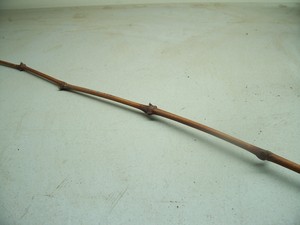Early spring is a good time to propagate grape vines. Growing grapes from hardwood cuttings is a surprisingly easy and effective method for starting or expanding a home vineyard. Most grape types started from cuttings will begin bearing in three to four years, and a first year plant started from a hardwood cutting is often more vigorous than those purchased bare root at a garden center, and far cheaper as well.
Hardwood cuttings are material taken while the plant is in dormancy. Despite their lifeless appearance, hardwood cuttings are quick to root and grow when done at the right time. Vines for cuttings can be harvested in late fall or early spring. Late fall is the best time for areas with very cold winters, as much of the vine can be unusable due to cold damage by spring. Store fall harvested cuttings in the refrigerator until March. Spring hardwood cuttings can be used immediately, anytime through March and April. Make sure the vine is not actively beginning to leaf out, as this will retard rooting.
Rooting hormone helps speed up the process. This product is sold at most garden centers in a powder form. Rooting hormone is not overly dangerous if used properly, but rubber gloves and eye protection should be worn. The purpose of this product is to encourage root formation before rot sets in.
Prepare the cuttings by cutting them into short lengths of six to ten inches. Each cutting should have at least two nodes, and preferably three. Cutting length will vary considerably, as some vines have shorter internodal sections than others. Cut below the node that will be the base of the cutting, and above the node at the top. Buds should be facing upward.
Dip the bottom cut end lightly into rooting hormone. Too little hormone is actually preferable than too much. Only the cut surface should have powder clinging to it. Excessive hormone can burn roots when they finally do emerge.
Pots for grape cuttings should be four to six inches in diameter. Taller pots allow for more active root growth. Soil can be any commercially available sterile seed starting mix. A combination of 2/3 soil mix and 1/3 perlite will provide good drainage. Make sure the media is moist before inserting the cutting. Using a screwdriver or a pencil, make a hole in the media in each pot, about two to three inches deep. This technique helps keep as much hormone on the end of the cutting as possible. Seat the cutting in the hole and tamp down gently, so the grape is stable but the soil not overly compacted.
A heat mat and a grow light really do speed up the rooting process considerably. Although cuttings will root on a warm and sunny windowsill, the steady and even heat provided by the mat is what roots need to develop. A grow light will help top growth development after the buds begin to swell and leaf out. Cuttings should begin to form roots in two to three weeks.
Cuttings should be kept warm and under lights until they are fully leafed out. Check for root development by pulling one out of its pot. If the roots nearly fill the container, it may need to be repotted. Accustom the juvenile grapes to outdoor temperatures gradually. They can be left in a shaded place outside for a few days, being moved indoors at night. After a week of this treatment, a few hours of full sun can be given each day. After two to three weeks, the cuttings should be fully acclimated to outside temperatures and should be growing vigorously. A mild liquid fertilizer can be applied once a week until the plants are large enough to go into the ground. Young grapevines should be watched carefully over the summer. They tend to have high water needs, and even a brief dry spell can set them back or even kill them.







